- Home
- Prelims
- Mains
- Current Affairs
- Study Materials
- Test Series
28th Oct 2021
GOODBYE, COLUMBUS: VIKINGS CROSSED THE ATLANTIC 1,000 YEARS AGO
A study has shown that Vikings crossed the Atlantic 1,000 years ago. Highlights:
- A wood fragment from the Norse layers at the L’Anse aux Meadows Viking settlement established 1,000 years ago near Hay Cove, Newfoundland, Canada is found.
- Scientists revealed that the settlement was occupied in 1021 AD.
- A scientific dating technique was used on three pieces of wood cut for the settlement, all pointing to the same year.
- The new dating method relies on the fact that there was a significant solar storm, a burst of high-energy cosmic rays from the sun in 992 AD.
- The settlement offers the earliest-known evidence of a transatlantic crossing, 471 years before the first voyage of Christopher Columbus.
- The trip was both a voyage of discovery and a search for new sources of raw materials.
- The Viking age revolved around 700 to 1100 AD.
- The Vikings or Norse people were seafarers with Scandinavian homelands: Norway, Sweden and Denmark.
- They possessed extraordinary boat-building and navigation skills and established settlements on Iceland and Greenland.
- They travelled by longboat to other countries, like Britain and Ireland.
- The first Viking raid occurred in 787 AD. It was the start of a fierce struggle between the Anglo-Saxons and the Vikings.
- Christian monasteries in Britain were easy targets for the Vikings.
- The monks had no weapons and the buildings were filled with valuable treasures, like gold, jewels, and books.
- They travelled from Scandinavia to Britain. They mostly settled in the Danelaw, to the north and east of England.
- Norwegian Vikings sailed to Scotland. They made settlements in the north, and on the Shetland and Orkney Islands.
- In Ireland, the Vikings founded the city of Dublin.
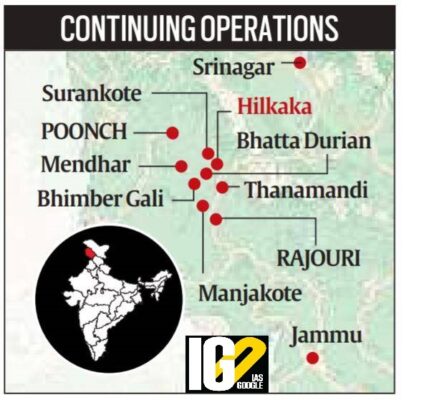
- The operation was to eliminate the terrorists who made bases in the region.
- The clearing of Hilkaka was the biggest counter insurgency operation in Jammu & Kashmir.
- The operation took place in a 150-sq-km area between three major ridges on the western part of the Pir Panjal.
- According to the Indian Army, the total number of militants killed was 62.
- 15,000 troops were involved in the operation that lasted for two weeks.
- Mi-17 helicopters were used to airlift troops to Hilkaka, and Lancer attack helicopters were used to bust concrete bunkers at high altitudes.

- In the Union Budget 2020, excise duty was raised as a revenue measure, by way of National Calamity Contingent Duty on cigarettes and other tobacco products. However, no change is being made in the duty rates of bidis.
- National Calamity Contingent Duty (NCCD) is levied as a duty of excise on certain manufactured goods specified under the Seventh Schedule of Finance Act, 2001.
- The National Calamity duty chargeable shall be in addition to any other duties of excise chargeable on such goods under the Central Excise Act, 1944 (1 of 1944) or any other law for the time being in force.
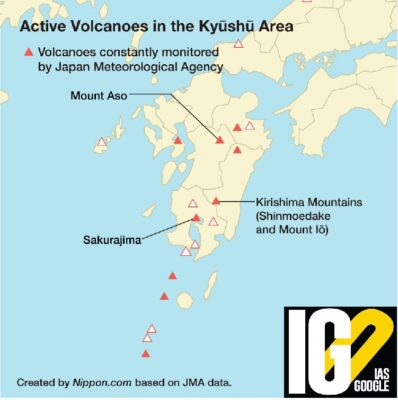
- Mount Aso is an active volcano in the center of Kyushu, Japan.
- Aso's ancient caldera ranks among the world's largest, with a diameter of up to 25 kilometers and a circumference of over 100 kilometers. It is surrounded by five peaks, known collectively as Aso Gogaku.
- In the center of the caldera stand the mountain's active volcanic peaks, including Mount Nakadake, whose spectacular crater is accessible to tourists.
- Japan has 110 active volcanoes and monitors 47 constantly.
- Japan accounts for about 20 percent of the world’s earthquakes of magnitude 6 or greater.
 Konkan Shakti is one of the biggest joint exercises between Indian armed forces and United Kingdom’s Carrier Strike Group (CSG).
Konkan Shakti is one of the biggest joint exercises between Indian armed forces and United Kingdom’s Carrier Strike Group (CSG).
- Konkan Shakti is the first tri-service exercise between India and the United Kingdom.
- The exercise highlights the re-entry of the UK’s Carrier Strike Group (CSG) into western Indian Ocean waters.
- The CSG, along with HMS Queen Elizabeth, has been on deployment in the Indo-Pacific waters for all summer.
- Deployment of CSG is significant for the UK as it is the biggest deployment after the end of the Cold War.
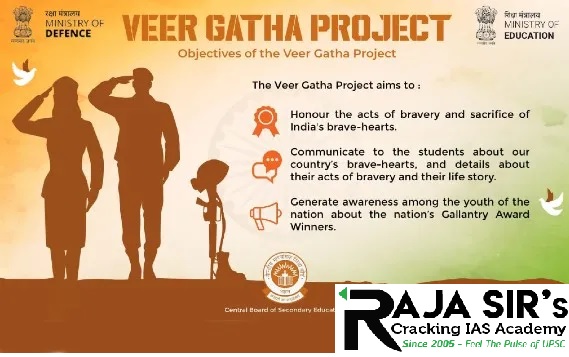 The project 'Veer Gatha' aims to make school students aware of the gallantry award winners.
The project 'Veer Gatha' aims to make school students aware of the gallantry award winners.
- Central Board of Secondary Education (CBSE) has launched the ‘Veer Gatha Project’ for students from grades 3-12.
- The project aims to:
- To commemorate the courage of the armed force officers and personnel.
- To honour the acts of bravery and sacrifice of the officers/personnel of the Armed Forces, other lawfully constituted Forces, and Civilians.
- The students can frame different projects on gallantry award winners and the best project will be awarded by the Ministry of Defence (MoD) and Ministry of Education (MoE) on the forthcoming Republic Day.
- Interdisciplinary and art-integrated activities like the poem, essay, painting, multi-media presentation, etc. can be done by individual students as a project to participate.
 The draft directions propose:
The draft directions propose:
- Minimum capital ratio of 11.5% of total risk weighted assets (RWA).
- AIFIs to maintain a capital conservation buffer in the form of common equity at 2.5% of RWA, in addition to the minimum capital adequacy ratio of 9%.
- Raising common equity in tier-1 capital to 5.5% of RWA.
- The minimum tier-1 capital at 7% and the capital conservation buffer at 2.5%.
- To impose Capital distribution constraints on an AIFI when capital level falls within this range.
- It is a group composed of Investment Institutions and development finance institutions.
- They fall under the jurisdiction of Reserve Bank of India.
- They assist in the proper allocation of resources, sourcing from businesses that have a surplus and distributing to others who have deficits – this also assists with ensuring the continued circulation of money in the economy.
- They act as an intermediary between borrowers and final lenders, providing safety and liquidity. This process subsequently ensures earnings on the investments and savings involved.
- Basel norms are international banking regulations issued by the Basel Committee on Banking Supervision (BCBS).
- It is an effort to coordinate banking regulations across the globe, with the goal of strengthening the international banking system.
- The BCBS consists of representatives from central banks and regulatory authorities from 28 jurisdictions. It has 45 members (including India).
- The BCBS was formed without a founding treaty to address the problems presented by globalization of financial and banking markets in an era in which banking regulation remains largely under the purview of national regulatory bodies.
- The BCBS serves to help national banking and financial markets supervisory bodies move toward a more unified, globalized approach to solving regulatory issues.
- Its secretariat is located at the Bank of International Settlements (BIS) headquartered in the city of Basel in Switzerland. Hence, the name Basel norms.
- The Basel Committee has issued three sets of regulations as of 2018 known as Basel-I, II, and III.
- Basel III is a comprehensive set of reform measures designed to improve the regulation, supervision and risk management within the banking sector.
- Basel norms comprises of three pillars introduced in Basel II Norms:
- Minimum capital requirements (Pillar 1): Banks to maintain minimum capital adequacy requirement of 8%.
- Supervisory review (Pillar 2): Develop and use better risk management system
- Market discipline (Pillar 3): Requires disclosure of CAR, risk exposure to the Central Bank (RBI in case of India).
- Basel III aims to focus on 4 important banking parameters: Capital, Leverage, Funding, Liquidity.
- Tier 1 capital refers to the core capital held in a bank's reserves including common stock, as well as disclosed reserves and certain other assets and is used to fund business activities for the bank's clients.
- Tier 2 capital includes undisclosed funds that do not appear on a bank's financial statements and revaluation reserves.
- It is supplementary capital because it is less reliable than tier 1 capital.
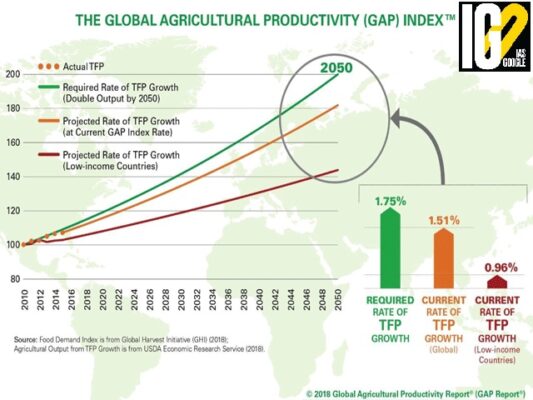
- Total factor productivity (TFP) is growing at an annual rate of 1.36 per cent (2020-2019).
- TFP tracks changes in how agricultural inputs like land, labour, fertiliser, machinery, are transformed into outputs like crops, livestock, and aquaculture products.
- Climate change has reduced productivity growth globally by 21 per cent since 1961.
- Low-income countries: contracting by 0.31 % per year due to minimal investments in agricultural research and development (R&D).
- Middle-income countries (including India): continued to have strong TFP growth rates.
- High-income countries (including North America and Europe): modest TFP growth.
- Drier regions of Africa and Latin America: slowed productivity growth at 34 % per year.
- In India an average annual TFP growth stood at 2.81 percent and output growth is 3.17 percent (2010–2019.)
- Rising temperature, and changes in rainfall patterns, could cut yields for India’s major food crops by 10 percent by 2035.
- As per the Ministry of Agriculture, out of the 147 million landholdings in India, 100 million are less than two hectares in size.
- The inefficient use of labor contributes to high rates of rural poverty and food insecurity.
- Invest in agricultural research and development.
- Embrace science-and-information-based technologies.
- Improve infrastructure for transportation, information, and finance.
- Cultivate partnerships for sustainable agriculture, economic growth, and improved nutrition.
- Expand and improve local, regional, and global trade.
- Reduce post-harvest loss and food waste.
 According to the report released by The NASA Earth Observatory:
According to the report released by The NASA Earth Observatory:
- The two lakes — Chibzhang Co and Dorsoidong Co - a small range in the central part of the Tibetan Plateau, west of the Tanggula Mountains — grew larger between 1987 and 2021 due to glacial melting.
- The Hindu Kush is an 800-kilometre-long (500 mi) mountain range in Central and South Asia to the west of the Himalayas.
- It extends across 3,500 km over eight countries—Afghanistan, Bhutan, Bangladesh, China, India, Myanmar, Nepal and Pakistan.
- The eastern end of the Hindu Kush in the north merges with the Karakoram Range. Towards its southern end, it connects with the Spin Ghar Range near the Kabul River.
- It is referred to as the Third Pole.
- It is also known as the Water Tower of Asia due to its reserve of frozen water.
- They are the biggest reserves of water in the form of ice and snow outside the polar regions, and source of 10 of the largest rivers in Asia.
- The glaciers are the lifeline for one-third of the population across the globe.
- It has the world’s highest amount of snow and ice outside the polar region.
- Much of the Hindu Kush comprises metamorphic rock, including metamorphosed granodiorite and metamorphosed sedimentary rocks of amphibolite and greenschist facies.
- Rainy or snowy summers (from July to September) and dry winters.
- The central and western Hindu Kush borders the Mediterranean climatic zone, characterized by hot, dry summers and cold, wet or snowy winters (from December to early March).
- Forests cover many southern slopes of the eastern and central Hindu Kush.
- Large stands of deodar cedar and blue pine cloak the eastern and central spurs of the Hindu Kush.
- In the western Hindu Kush, forest is almost absent, and cultivated fodder trees such as poplar, willow, and Russian olive predominate.
- Other planted trees in irrigated mountain passes include plane trees and economically valuable species such as mulberry, jujube, and walnut.
- Meadowland is intermittent, depending on sunny and shady exposure, with substantial pastures found on slopes where snow accumulates.
- The Siberian ibex and the Markhor (both wild goats) are found in the high crags.
- Marco Polo sheep and Urial (another wild sheep) occasionally are found in the high Pamir.
- Black and brown bears exist in isolated valleys.
- Chitral valley wildlife preserve is a domain of the rare snow leopard.
- Birdlife of the mountains includes vultures and eagles.
- The streams of the northern slope contain brown trout in abundance.
- Forage, timber, and water are highly exploited resources.
- Human settlements occur where land can be irrigated.
- Large seasonal migrations of livestock, driven by herders, fully utilize the pasturelands of remote mountain areas.
- Thousands of sheep and goats from the high pastures of Badakhshan travel through the Anjoman Pass down to the markets of Kabul.
- Small hydroelectric power plants generate electricity for mountain villages
- Small irrigated plots of wheat, barley, millet, corn (maize), potatoes, and peas and beans constitute the region’s agriculture.
- Barbados is not the first former British colony in the Caribbean to become a republic, before Guyana, Trinidad, and Tobago declared themselves republic states.
- Definition: It is a form of government in which the power is held by the people and their elected representatives.
- Principles:
- The power and authority of government come from the people, not some supreme authority, or king.
- The rights of the people are protected by a written constitution and through the vote of the people.
- The citizens give power to elected representatives, based on majority rule, to serve their interests and act on their behalf.
- The representatives are responsible for helping all the people in the country, not just a few people.
- The stability of government rests with the people and is dependent on civic involvement.
- Advantage:
- Laws made by elected representatives are meant to be fair. If people find laws unfair, they can elect other leaders who can change those laws.
- A republic allows greater freedom and prosperity. Economic pursuit benefits the entire nation and people can live well.
- When government serves the interests of the entire country, we say it is serving the common welfare.
- There is wider participation in the political process. According to the Declaration of Independence, all men are created equal; therefore, it did not matter if you were a small farmer or a powerful aristocrat. Ordinary people are welcome to participate in government.
- Leaders emerge based on people's talents, not their birthright.
- Civic virtue is promoted. Civic virtue includes demonstrating civic knowledge (how government and the political process works), self-restraint, self-assertion, and self-reliance.
- Change and reform come about by vote, not by force.
| Categories | Democracy | Republic |
| Definition | It is the form of a government where people choose their representatives to legislate them. This means it is a government by the people, for the people, of the people. It is a form of government where the people have the authority. | It is the type of Government where the country is considered a Public Matter. It is derived from the term Res Publica. |
| Types | There are 3 major types of democracy – Direct democracy, Representative Democracy, Constitutional Democracy | The 5 types of Republics are Constitutional Republic, Parliamentary Republic, Presidential Republic, Federal Republic, Theocratic Republic. |
| Power | In Democracy the people have the power to themselves. | In Republic form of Government, the power belongs to individual citizens |
| Constraints | There are no constraints on the Government in a Democracy. | There are constraints on the Government in a Republic. |
| Focus | Democracy majorly focuses on the general will of the people | Republic mainly focuses on the Constitution. |
| Laws | In a democratic system of Government, all laws are made by the majority | In the Republic form of Government, the laws are made by those who are elected representatives of the people of the land. |

- Deliberated on the USD 1 trillion Solar Investment Roadmap for 2030 including a blended finance risk mitigation facility.
- Approved the “One Sun “political declaration for the launch of Green Grids Initiative-One Sun One World One Grid (GGI-OSOWOG) at COP 26.
- ISA forged partnership with Bloomberg Philanthropies and Global Energy Alliance for People and Planet.
- It focused on strategy for Private Sector Engagement, and initiatives like Viability Gap Financing scheme to provide affordable finance for solar energy projects across all members of the ISA.
- Solar Hydrogen programme:
- Aim: Enabling the use of solar electricity to produce hydrogen at a more affordable rate than what is available currently.
- Making hydrogen cost competitive with natural gas presents major challenges for both supply and performance.
- Waste Management Programme:
- It will address the challenges of
- Growing volume of waste, toxic materials
- lack of waste-specific legislation, high cost of waste treatment.
- ISA is an international organization comprising 98 member countries that have signed the ISA Framework Agreement.
- It was launched in Paris, France on November 30, 2015.
- Headquarters: Gurugram, India.
- It helps governments across the world in improving energy access and security around the globe
- It focuses on promoting solar energy as a sustainable way to transition to a carbon-neutral future.
- Sela pass connects Tawang and the plains of Assam.
- Tawang Monastery is the largest Buddhist monastery in India.
- Primarily inhabited by the Monpa tribes.
- Flora: Wide variety of tree species, blue pines and orchids
- Fauna: High altitude birds, snow leopard, musk deer, barking deer and bear.
- It is an indigenous multi rocket launcher system (MLRS) designed by Defence Research and Development Organization.
- It is an autonomous rocket artillery system that can engage area targets up to 38km at mean sea level.
- It delivers very high volume of firepower on critical and time-sensitive enemy targets in a very short time.
- It has quick reaction time and the highly accurate.
- Pinaka is named after the bow of Lord Shiva.
- It is procured from Russia.
- It is the longest-range conventional rocket system in Indian army inventory having a maximum range of 90 Km.
- The Smerch MLRS is composed of a launch vehicle, transloader, rockets, training facilities and arsenal equipment.
- The BrahMos is a medium-range ramjet supersonic cruise missile that can be launched from submarine, ships, aircraft, or land.
- It is the fastest supersonic cruise missile in the world.
- It is a joint venture between the Russian Federation's NPO Mashinostroyeniya and India's Defence Research and Development Organization (DRDO).
- The name BrahMos is a portmanteau formed from the names of two rivers, the Brahmaputra of India and the Moskva of Russia.
- BrahMos has a flight range of up to 290km and can reach a maximum speed of Mach 3.
- The Fire and Forget type missile weights 3t and intercepts surface targets at an altitude of 10m up to 14,000m.
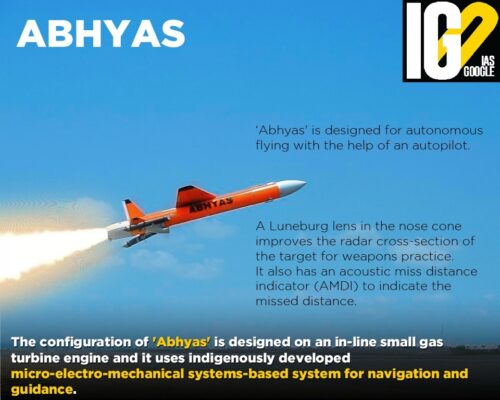
- Abhyas is a High-speed Expendable Aerial Target (HEAT) being developed by DRDO’s Aeronautical Development Establishment (ADE), Bengaluru.
- It is used as an aerial target for evaluation of various missile systems.
- Has an Acoustic Miss Distance Indicator (AMDI) to indicate the missed distance.
- Equipped with Inertial Navigation System (INS) along with the Flight Control Computer (FCC) for guidance and control.
- It offers a realistic threat scenario for practice of weapon systems.
- The vehicle is programmed for fully autonomous flight.
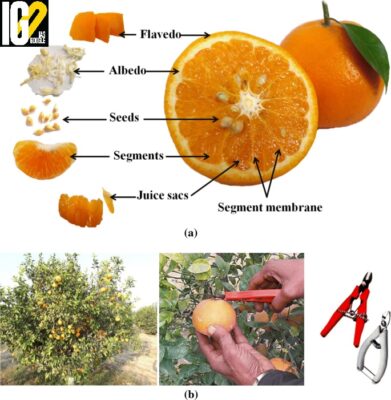
- Fallen fruit of the kinnow crop is nothing but the peel along with extremely tiny and small kinnow fruit that accompanies the regular-sized kinnow fruit.
- The fallen fruit which is also known as the ‘D’ grade kinnow fruit is considered as a waste product by the kinnow farmers and disposed of from the kinnow fields.
- However, recently, about 100 farmers from the Kinnow belt of the state have decided to utilise the fallen fruit in making Bio-enzymes.
- Abohar belt in the Fazilka district is the hub for kinnow production.
- Kinnow is a year-round crop.
- It’s primary harvesting season is from late November to early March.
- It is majorly grown in Punjab, Himachal Pradesh, Jammu & Kashmir, Rajasthan and even Haryana.
- Difference between orange and kinnow: While an orange is a hybrid of citrus reticulate and citrus maxima, kinnow on the other hand is a hybrid of citrus deliciosa and citrus nobilis.
- This hybrid variety of orange was developed and introduced by HB Frost in the year 1935.
- Nearly 15-20 % (1.5 lakh to 2 lakh tonnes) of the total kinnow production falls from the tree before and during the harvesting period which the farmers consider a total waste.
- Fallen fruit is a major challenge for kinnow farmers as one needs to dig up small pits to bury them, otherwise the fallen fruit rot and invite a fly attack on the healthy fruit still on the plants.
- Bio-enzymes are organic solutions produced through fermentation of organic waste including various fruits, vegetable peels and flowers, by mixing in sugar, jaggery/molasses and water.
- It takes 60-100 days to ferment organic waste.
- To fasten the fermentation, yeast can be used as culture to prepare it in 45-50 days.
- Improve the pH level and soil fertility of the land.
- Improves water, air, depleting ground water, water contamination and overall ecology.
- Plant health can be improved
- It also helps prevent indiscriminate usage of chemical sprays of fungicides and bacterial diseases on crops, especially vegetables, tuber crops like potato and cereals.

- Earlier, scientists from the Indian Agricultural Research Institute (IARI) have proposed a method which would allow plants to be genetically modified without the need for conventional transgenic technology.
- Unlike the older genetic modification (GM) technology which involves the introduction of foreign DNA, this new proposal involves the use of gene editing tools to directly change the plant’s own genes instead.
- In this direction, scientists at IARI are in the process of developing resilient and high-yield rice varieties using such gene editing techniques.
- One such editing technique is Site-Directed Nuclease (SDN) technology.
- However, Genetic Engineering Appraisal Committee has not yet approved this proposal and is pending since last 2 years.
- Site-Directed Nuclease (SDN) genome editing involves the use of different DNA-cutting enzymes (called nucleases) that are directed to cut the DNA at a predetermined location by a range of different DNA binding systems.
- After the cut is made, the cell’s own DNA repair mechanism recognizes the break and repairs the damage, using one of two pathways that are naturally present in cells.
- In SDN, scientists are just tweaking a gene that is already there in the plant, without bringing in any gene from outside.
- When a protein comes from an outside organism, researchers need to test for safety. But in this case, this protein is right there in the plant, and is being changed a little bit, just as nature does through mutation.
- This method is much faster and far more precise than natural mutation or conventional breeding methods which involve trial and error and multiple breeding cycles.

- Centre for Financial Literacy & Service Delivery (CFL&SD) will provide basic financial needs of Self-Help Group (SHG) households in rural areas.
- The Centers will be managed by SHG network, largely at Cluster Level Federations (CLFs), with the help of trained Community Resource Persons (CRPs).
- Ministry of Rural Development (MoRD) developed a mobile & web-based application “SAKSHAM” used by the community resource person of the Centre
-
- To know the penetration of various financial services for each SHG & village.
- Identify major gaps and accordingly provide training and deliver the required financial services.
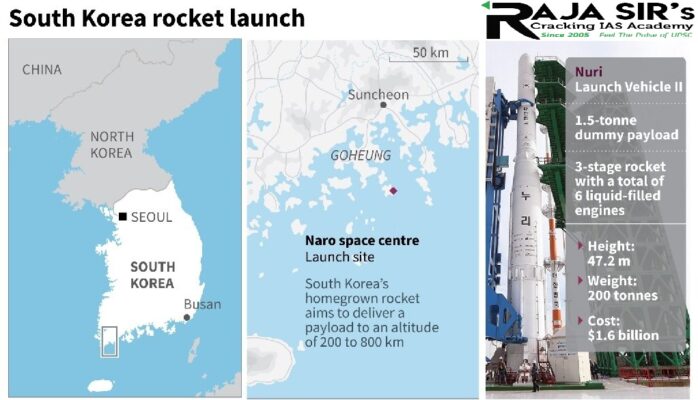 South Korea has launched its first homegrown space rocket Nuri recently from Goheung, Seoul.
South Korea has launched its first homegrown space rocket Nuri recently from Goheung, Seoul.
- Weighing 200 tonnes, Nuri is fitted with liquid-fueled engines.
- South Korea plans to carry out four more launches of the Nuri until 2027 to increase reliability.









 Latest News
Latest News
 General Studies
General Studies